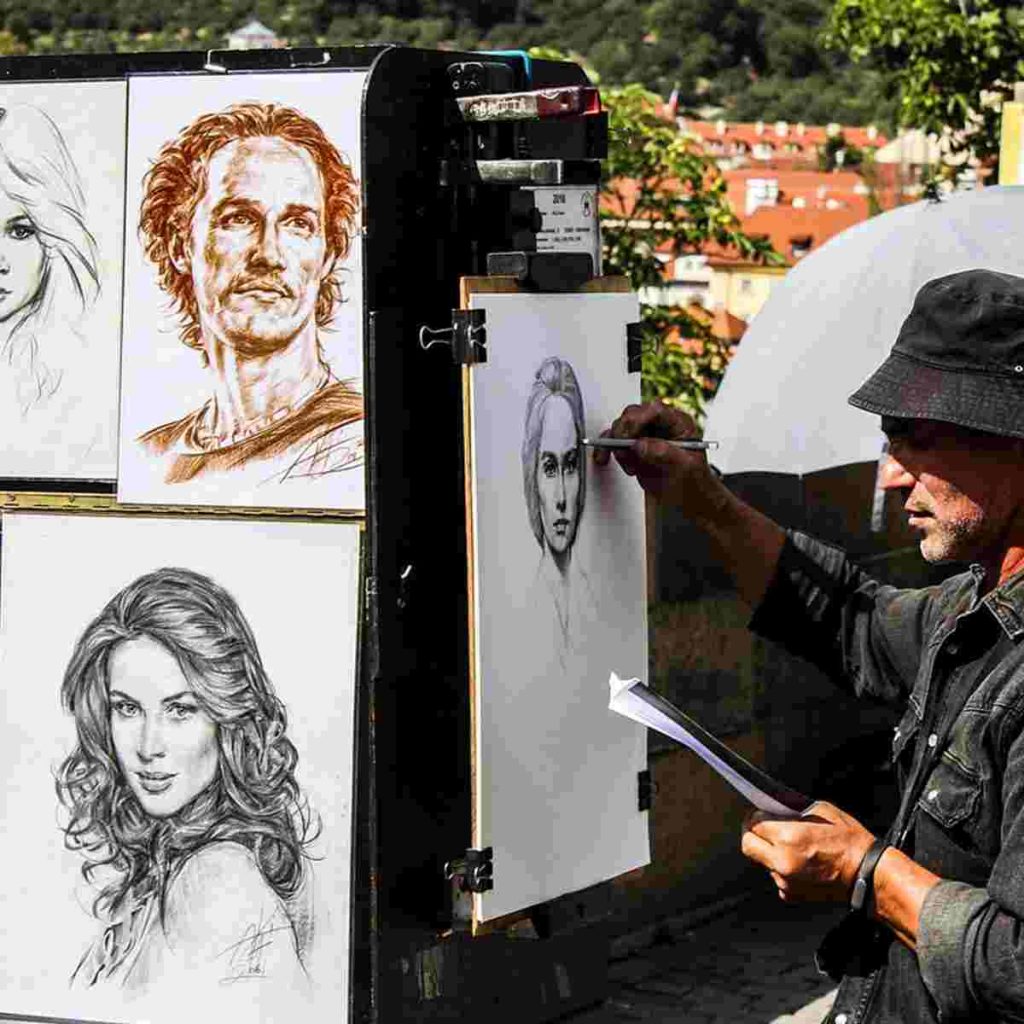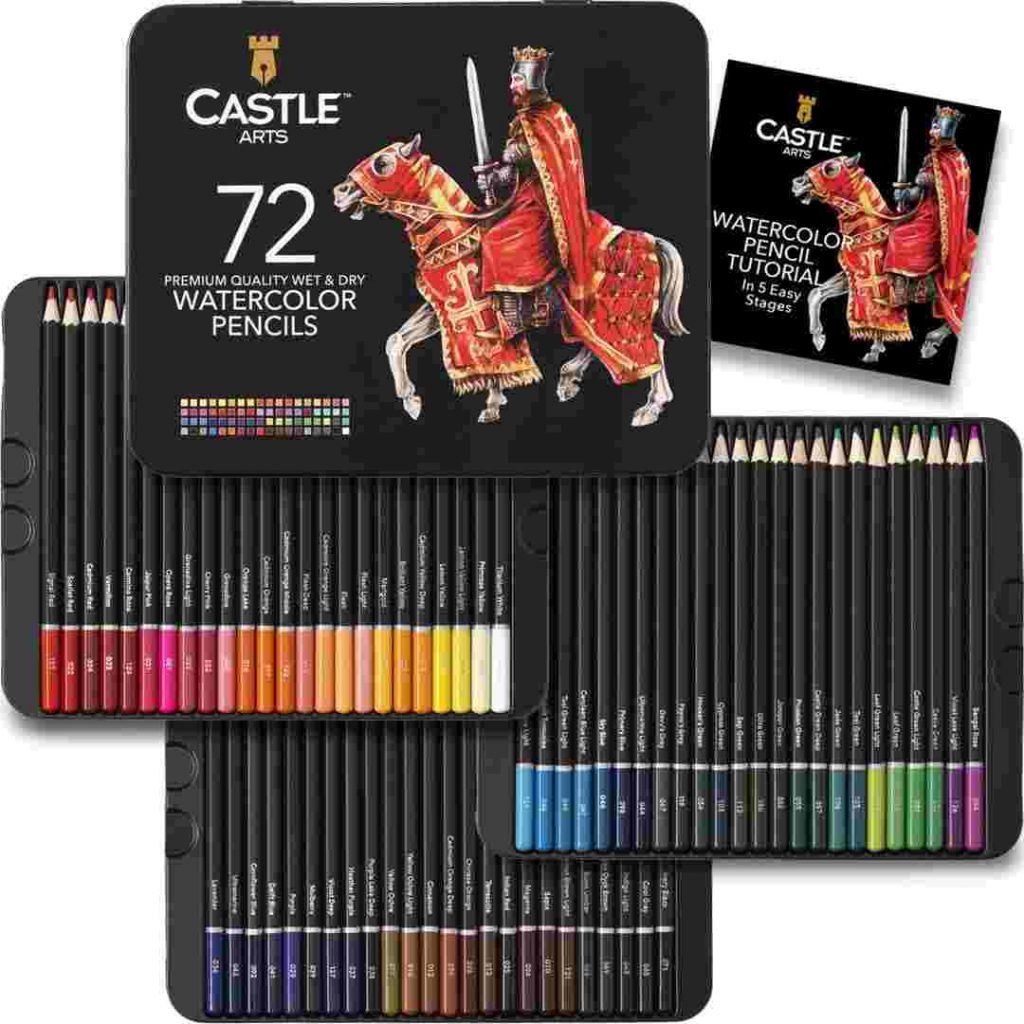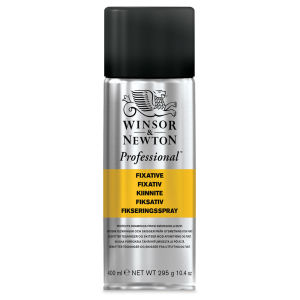Last Updated on November 19, 2023 by Masha Eretnova
Do you love painting but don’t know how to start and are afraid to go freehand? Don’t worry, I got you! In this article, we will show you how to sketch on canvas before acrylic painting in 11 different ways. This is a great way to get the creative juices flowing and make sure your final product looks exactly the way you want it to. So grab a canvas and some paint, and let’s get started!
So, How to sketch on canvas before painting it? The easiest yet least recommended way to draw on canvas before painting, is to use a simple graphite pencil. The most used methods by pro artists are the transfer method, white charcoal pencil, or a water-soluble pencil.
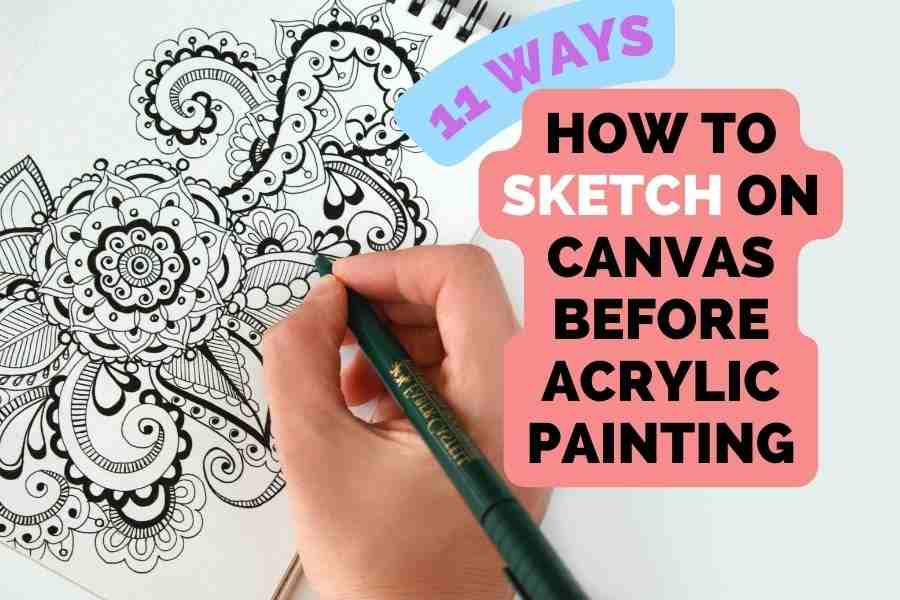
I’ll tell about more ways to sketch the canvas before painting and their pros and cons in this article such as colored pencils, pastels, markers, ink, and even acrylic paint itself!
Table of content
- Should I sketch on a canvas before painting or not?
- 3 Best methods to sketch UPFRONT
- What can I use to draw sketches on canvas?
- 11 WAYSHow to draw on canvas before painting it
- Sketching on Canvas FAQ
This article contains affiliate links that mean NO extra costs for you but a tiny commission for me to support my blog. Thank you, readers, you make this blog happen!
Should You sketch on a canvas before painting?
To be honest I’ve never sketched in detail before painting and there is no rule that you absolutely must do it. However, you can do it to ease the process and trace some important proportions or compositions – the sketch is your preliminary drawing.
To begin, you will need to sketch your design for the painting on canvas. This can be a simple outline of the overall composition, or it can be a more detailed drawing of the individual elements. Either way, it’s important to get your ideas down on paper (or canvas) before you start painting if you are not comfortable with free hands painting.
Once you have your sketch, you can start painting! Begin by adding the base colors for your composition. If you’re not sure what colors to use, try looking at some reference photos or paintings that you like. Remember that normally we paint dark to light with acrylics but it’s not mandatory. Once you have the basic colors down, you can start working on the details.
This is a great way to get started with painting, and it will help you to make sure that your final product is exactly what you want it to be. So grab a canvas and some paint, and give it a try! I think you’ll love the results.
Personal opinion: I do simple sketches very rarely if I’m copying a painting or painting a tricky landscape. However, I do most of my works in abstract. If you really would like to develop drawing skills, I would absolutely recommend trying sketching, as well as watching videos on the painting process.
Related Posts:
- How to Paint with Acrylics on Canvas [Supplies included]
- 38 Best Canvas for Acrylic Painting for Beginners in 2023 that Professionals use
- 101 Easy Acrylic Painting Ideas for Beginners on Canvas
UPFRONT: 11 Methods how to draw on canvas before painting it with Acrylic Paint
For NOT retaining the sketch and painting over it:
- 🥇 Transfer paper – the best method to sketch on canvas and most used by pro acrylic and oil painters. Helps to transfer all details and dimensions, and move the drawing around.
- 🥈 White charcoal pencil – great for sketches on toned or black canvases.
- 🥉 Water-soluble graphite pencil – great for not leaving marks with acrylics or watercolor.
- Regular H-grade graphite pencil. H-grade pencil is the easiest yet the least favorite method, as graphite can get messy and visible through the paint. However, thousands of painters still use this method!
- Regular black charcoal – great for rough sketches
- Projector – the best sketching method for murals
For retaining the sketch:
- Colored pencils
- Markers
- Pastel
- Ink
- Pencils/charcoal + fixative spray
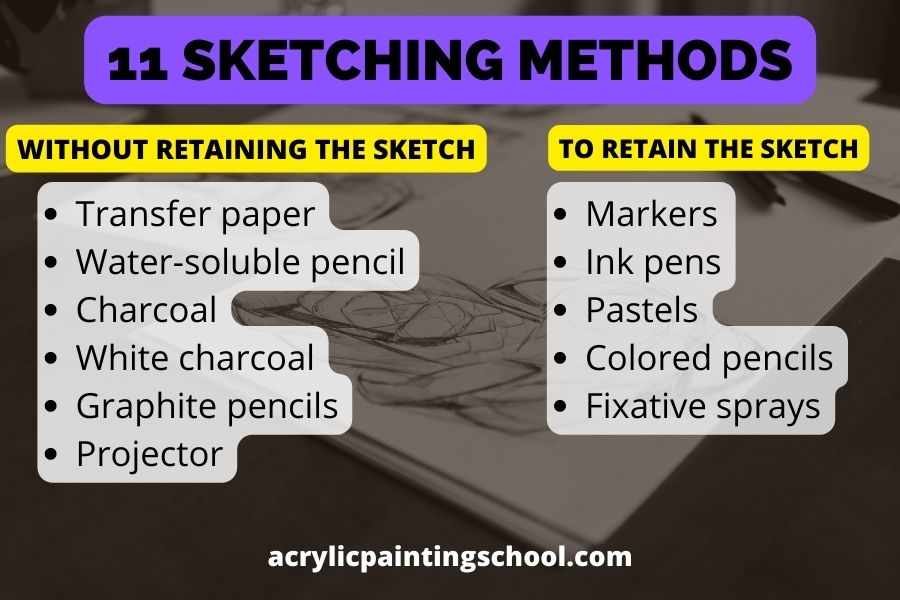
List of supplies for sketching Before Painting with Acrylic Paints
Depending on what method you will choose you may need one of the following:
- Transfer paper
- Graphite pencils
- Water-soluble pencils
- Pencils + fixative spray
- Charcoal
- White charcoal
- Colored pencils
- Markers
- Ink pens
- Pastels
- Acrylic paint
- Projector
- Kneaded eraser
11 Sketch Methods on canvas In Details
- 🥇 Transfer paper – the best method and most used by pro painters.
- 🥈 White charcoal pencil
- 🥉Water-soluble graphite pencil.
- Regular H-grade graphite pencil. H-grade pencil is the easiest yet the least favorite method, as graphite can get messy.
- Regular black charcoal – for not retaining the sketch
- Projector ( great if you have one but too expensive to sketch if you don’t, so not a universal method)
For retaining the sketch:
- Colored pencils can create a color wash when you paint acrylics and can get messy. I would use it either separately, or on a specific area that won’t be painted (unless a light color wash is what you’re looking for, like background.
- Pencils with fixative sprays.
- Markers – if you use permanent markers like Sharpie or any others, marker lines won’t wash away. Sharpies come both in black and color packs.
- Pastels are great for painting by themselves and will create beautiful sketches, however, it is more for mixed media, artwork as itself than for sketching before painting acrylics.
- Ink pens – perfect for mandala drawings, fine details, and lines, you can use them to draw lines or silhouettes and combine them with acrylics
#1 Transfer paper – The cleanest and Pro sketching method
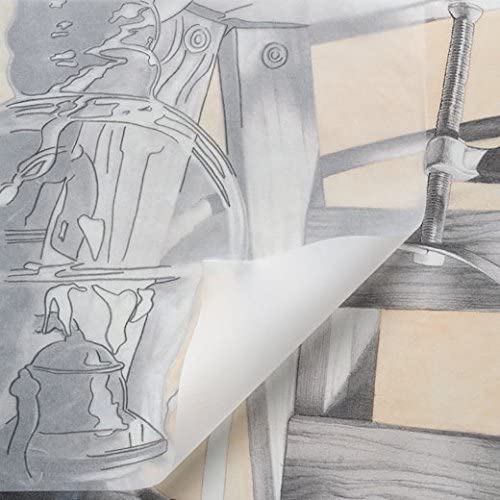
The transfer method is one of the most popular among painters and it is also quite an easy one! It works great both to completely copy a drawing and freehand. And it has a lot of advantages compared to other methods:
- Removes the stress of freehanding for beginners.
- Is not messy at all! All the drawing happens on paper and the canvas remains clean.
- Allow you to move the transfer paper to choose the best placement for the elements, and to check the sizes and proportions.
- Having a transfer paper you can always double-check all sizes and positions of each element.
- Can be replicated! Once you made a transfer you can keep it and make another similar painting again.
- The transfer method also helps you place an element on the background you’ve done already. This way you can first check the size of the element and its position by simply moving the transfer paper around and then, once you’ve found a perfect spot, paint it.
- You don’t even have to buy transfer paper every time, you can make it or even use a no-paper method!
Cons:
- you will probably need to buy the transfer paper
- it takes additional time to first sketch or fully draw the future painting on paper. (For me personally, it’s the biggest drawback – I am not so patient!).
- I don’t see how it will work on a very large canvas. Only if you’re drawing background sort of freehand first on the canvas and sketching on paper a few separate elements you’re not sure about.
Best Transfer paper for sketching
Greaseless black (graphite grey) or white transfer paper is the best choice for sketching on canvas, red or yellow are rarely needed to be honest. The best artist-grade transfer paper brands are Saral (the most famous), Loew Cornell, Sally’s., Strathmore, Royal Brush, and others.
It is best to buy a roll and cut it as you wish, but if you know for a fact that you are only drawing a specific size, then it makes sense to buy a pad with 50 sheets of a specific size (like this Strathmore pad).
How to sketch on canvas before acrylic painting with transfer paper
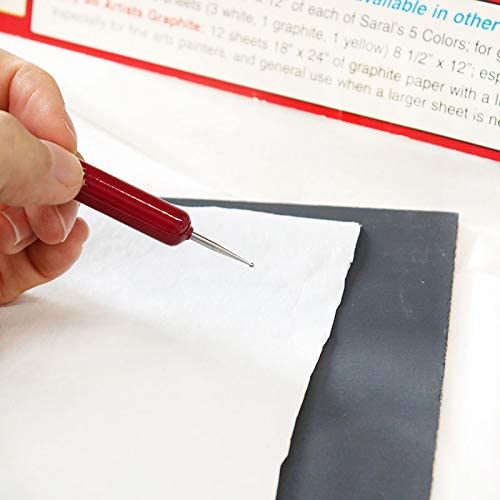
You will need:
- Regular paper sheet
- Transfer paper
- Graphite or charcoal pencil
- On a regular piece of paper make a sketch of the element or your drawing with a pencil. Yes, we are doing a drawing on regular paper first, not on transfer paper as we will probably use an eraser and redraw something and the transfer paper is quite fragile. Make it as detailed as you need.
- Once you’ve done, place the transfer paper on the canvas, and the paper you drew on top of it. Find the right spot.
- Make sure they are both fixed tightly on the canvas (use the artistic tape) and won’t move in the middle of the transferring process.
- Trace the lines and details going over your drawing. Regularly check what it looks like on canvas.
How to Transfer the drawing on the canvas WITHOUT transfer paper.
- On a regular piece of paper make a sketch of the element or your drawing with a pencil.
- Flip the paper. You can see the element you draw. Using an H-2H pencil or charcoal, and pressing firmly, shade the whole element on the paper. Cover the whole element very thoroughly with graphite. This step is helping us to kind of imitate the presence of transfer paper. When we will be tracing lines, the graphite we put on the back of the paper will adhere to the canvas.
- Flip back the paper so the covered side is onto the canvas. Place it on the canvas and move to find the right spot.
- Hold the paper tight. Pressing hard on your pencil, trace the drawing line by line, going a few times along the same line – this way you’re transferring your sketch to the canvas.
- Done! Now you are free to paint it with acrylic paint.
Alternatively, you can use carbon transfer paper, the principle is the same.
#2 Graphite pencil – Easiest yet least recommended
Pencils are the most accessible and simple way to sketch your future drawings and it works for beginners. Everyone has a graphite pencil and this method doesn’t require any extra supplies. However, some pro painters hate this method and prefer charcoal or transfer paper.
For me, as long as you can keep your line thin and don’t go hard on your pencil, and if you just need a few tracing lines for composition – pencils work fine! It is also a good way to make a very detailed drawing on canvas before painting it, but I would not recommend it.

Best pencil to sketch on canvas before acrylic painting
The rule of thumb for art beginners is to buy an HB-grade pencil, but you can also use H, lighter 2H, 3H 4H, and bolder 2B, 6B, and 9B, to draw a sketch before painting on canvas with acrylic paint. The best artist-grade pencils brands are Faber-Castell, Koh-i-Noor, Tombow, Staedtler, Derwent, Caran D’Ache, Conté à Paris, and Mr. Pen.
Cons of using pencil Lines to sketch before painting acrylics:
- The graphite can be visible through the paint, especially through more transparent colors or if you are using the watercolor (wet) technique.
- When you were sketching the details of your future painting, you were probably pressing quite hard, and sometimes these lines will be still visible on the painted canvas.
- When you go into too many details with a pencil, you turn your painting into a paint-by-number canvas with very little freedom, and you are not improving your techniques.
- Graphite marks are harder to remove than charcoal marks and regular pencils can smudge.
How to draw the canvas before painting it with a graphite pencil?
You’ll need:
- an HB graphite pencil. But honestly, people are using both H-3H and B-9B to sketch, depending on purposes and if shading is needed, etc. For just a simple sketch before acrylic paint, take HB or Hs pencils.
- kneaded eraser (works best with graphite on acrylic-primed canvas, don’t use it for oil-primed surfaces).
- Sharpen your pencil to create clean, thin lines. Choose a good pencil for sketching.
- Check on a piece of paper that your pencil lines are not smudging easily. Otherwise, it will all get messy.
- Sketch your future painting on the canvas before actually painting it, you can make it as detailed as you want or just trace guiding lines. Don’t press too hard on your pencil. Create gentle, thin lines. If you think you did something wrong or made a thick line, gently use an eraser to correct it.
- Work on the details and make sure to use reference photos or paintings. Scale the perspective and sizes of objects if necessary.
You may think, well it’s cool but I CAN’T draw or sketch! I’m terrible at it…so what do I do? Sketching as prep for painting or as hobby as it is is a skill, not something granted. With practice you will get it.
But you feel like you need a solid theory base and anything you draw with pencils should not see the world, there is a cool e-book with 18 chapters created by an artist on how to sketch ANYTHING with many drawings for you to copy and learn faster. It is guaranteed that you will be doing cool sketches within 60 days or she will give you money back!
#3 Water-soluble graphite pencil
In case you absolutely want to use a graphite pencil, but don’t want to deal with the mess or visible lines, you may use a water-soluble graphite pencil for acrylics or watercolor! As acrylics are also water-based and water-soluble, sketching with a water-soluble pencil can be super easy and won’t leave traces. Don’t ever press too hard on the pencils so you won’t have the deep tracing lines on canvas staring at you once you finished the painting.
3 Best Water-soluble graphite pencil sets:
- Faber Castel water-soluble pencils set, 5 pencils: HB, 2B, 4B, 6B, and 8B – best not only for sketching before acrylics but also for watercolor.
- Derwent Watersoluble Sketching Pencils, 6 pencils: two HB, two 4B, two 8B, and a sharpener. Very soft and durable, as well, works amazing for both watercolor and acrylic paint.
- Arteza Professional Watercolor Pencils, 3 pencils, you can choose colors – good and affordable choice for students and beginners.
#4 Charcoal – The best way to sketch rough proportions
Charcoal is a great way to trace rough proportions, composition, and lines, and it will not create a very detailed sketch. Drawing with charcoal right onto the canvas can work both for copying a reference picture or creating something from your fantasy to see how it will look in real life. Both black and white charcoal is good for sketching, and white is especially nice for dark backgrounds or black canvases.
Charcoal sketching is perfect for landscapes, however, some charcoal can get messy and will cover the canvas pretty well if you paint in details or shade some elements. Not all color pigments will be able to cover it up. Yet, compared to simple graphite compressed charcoal is better as graphite will be visible through oil, acrylics, or watercolor, while rough fine charcoal lines won’t.
Charcoal is great next step after mastering detailed pencils sketches to improve your freehand technique and free your imagination.
Cons working with charcoal:
- Sometimes charcoal is messy, use paper or napkin between the canvas and your hand, if you like to rest your hand on the canvas.
- If you shaded and painted the whole canvas with charcoal, it will be hard to cover it with some colors or it can even blend with acrylics. It is problematic to paint when you covered the canvas thoroughly in charcoal but want to have thin or washy acrylic paint layers.
Best charcoal for sketching:
Simple charcoal sticks or charcoal pencils work amazing for rough, not detailed sketches.
#5 White charcoal – The best sketching method for black and toned canvases
If you have a toned canvas, a black canvas, or an already painted background and you need to sketch something, white charcoal may be the way to go. Of course, you can intentionally tone the canvas to use white charcoal.
White charcoal has some pros compared to its brother black charcoal:
- Less visible but adhere well to canvas and paint.
- Doesn’t mess with your paint – doesn’t blend with it ( of course your paint layer should be dried), so don’t alter the colors. There is no issue with covering up white charcoal.
The best white charcoal to use for sketching on toned or black canvases is General’s white charcoal sticks or pencils.
How to sketch on canvas before acrylic paint with charcoal:
- You can directly draw a rough sketch with charcoal on the canvas. Try to not rest your hand on charcoal-covered areas or use paper to keep both your hands and the rest of the canvas clean.
- Don’t go into too many details and shading if you are planning to paint acrylics over a charcoal sketch. Just sketch the main elements and the composition.
#6 Projector – The best sketching way for murals

If you have a projector you can easily use it to transfer an image onto the canvas. It is a super handful as you can technically upscale/downscale a painting of any size onto the canvas or even a wall.
How-to:
- Connect the projector to your computer. Open your Sketch file or drawing (for digital projectors only). Make sure the projector and the surface (paper, canvas, wall, doesn’t matter) are in parallel.
- Scale the image so it’s clear and fits the size of the canvas.
- Trace with a pencil, charcoal, or paint itself. Done!
Best art projectors for tracing:
There are digital projectors that will fetch an image from your laptop and show it on the projected surface and opaque projectors – will only trace light through the physical picture you drew.
If you want to buy a projector, you need an “art” projector, meaning one that is actually recommended by artists. LG, SONY, and Kodak make good-quality projectors that can be used for tracing purposes. There is even a special projector for artists – a digital Artograph Digital Art Projector considered the best-dedicated art projector nowadays.
How To Sketch Canvas to Retain the Sketch
If you want to retain the sketch (when it is a fairly detailed drawing or a very detailed one) you will absolutely need to work on primed canvas. Otherwise, if you’re sketching an unprimed canvas that you will later prime with gesso, your sketch will be gone.
#6 Markers
Some artists will use markers from Sharpies to Copic for their preliminary drawings. This method only works if you don’t mind keeping the initial sketch. It is a nice option to work with mixed media and create original art, but I don’t personally see it as a very conventional and good way to sketch a future painting for a beginner acrylic painter.
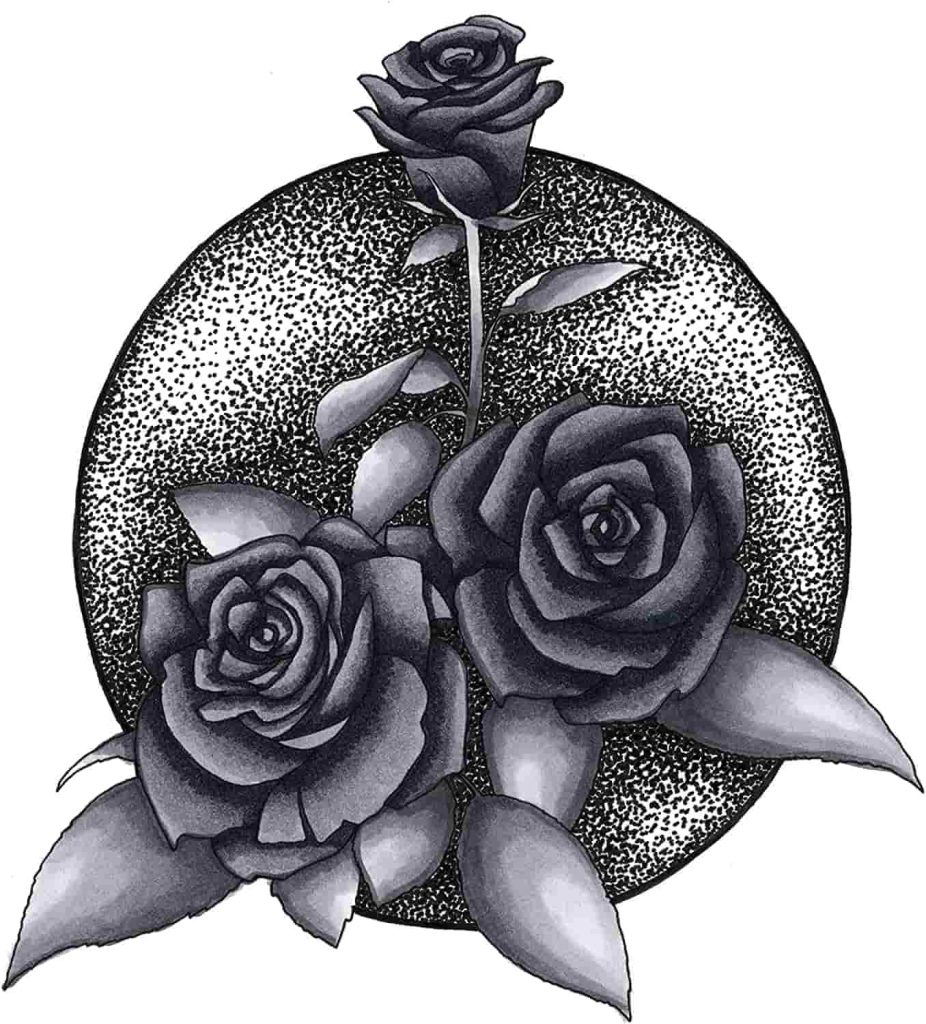

If you still want to paint with acrylic paint over markers sketch I would suggest buying acrylic markers to make sure the mediums are compatible between them. Some painters also cover the markers’ sketch with matte medium or layer of acrylic gesso to kind of seal it and make it less visible and runny.
Cons:
- Markers’ lines will be most definitely visible through the paint.
- Hard, impossible, to correct mistakes ( you can’t erase the marker).
- Some oil-based markers (Sharpie is one of them) can bleed through paint!
- If you’re using colored markers, remember that they can blend just like paint.
If you’re ok with retaining the sketch and are confident in your skills, you can use either regular markers or special sketching markers:
- Copic Markers for sketching – a set with 5 gray markers of different shades and 1 liner pen. Those markers are ink-based and are permanent.
- Sharpies have a set of black markers and regular multicolor sets of markers with fine tips.
- Acrylic markers like Arteza or Nuitop – are ultra multi-purpose and you will definitely use them not only for sketching.
Always test how runny or messy markers are on a separate piece of paper.
#7 Pastels
Pastels for sketching on canvas before acrylics can work like charcoal – for a rough sketch and basic shapes. Keep in mind that oil pastel is not compatible with acrylic paint. Better choose soft or chalk pastels. Pastels most often come in sets which is very convenient!
Faber Castell’s soft pastels are great for beginners, while Schmincke pastels may surprise even pros.
Same as with charcoal, you only trace major lines and elements without going into details.
In general, pastels work very well with acrylics, especially, when you need to create highlights and even blend paint with pastel. But the same advantage in painting is a drawback in sketching – we don’t always want and need our sketch to blend with acrylic paint. Again, pastels sketch is great for oil paints, but acrylic paint won’t work as great, better leave it as it is or test it and see how soft pastel performs.
#8 Ink Pens
Ink pens are amazing for drawing and sketching, especially fine lines and highly detailed projects. They are the most popular choice for mandala drawings. And it is better to use it as it is, for drawing than as a sketch medium under acrylic paint. However, you can still use it with acrylics if you will take some extra preventive steps.
Cons of using ink to sketch:
- can bleed and get messy if you’re using it with paint.
- will be visible through transparent paint layers.
- no right to mistakes – you can’t erase and correct the ink.
How to Sketch with Ink Pens before acrylic painting:
- Draw the sketch using ink pens, and let them dry if needed.
- If you want to apply acrylics over ink pens, we need to seal the ink sketch. Apply 2-3 coats of clear matte acrylic spray or medium and let it dry.
- Once the matte finish dries, you can paint.
#9 Colored pencils
If you painting with acrylic paint and want to create a full-size beautiful colored sketch, use watercolor pencils.
Sketching with colored pencils is more like drawing and you can definitely leave the painting as it is.
On the other hand, I would not use this method for sketching before acrylics simply because of the time and effort question. You basically make the same painting with two different mediums two times.
Great watercolor colored pencils:
- Faber Castell aqua watercolor pencils, set of 12.
- Castle Art Supplies watercolor pencils, the ultimate set of 72 pencils – extremely affordable for that amount of pencils.
- Derwent watercolor pencils, set of 12.
Cons of using regular colored pencils for sketching before painting:
- Too much time wasted (for me)
- Regular colored pencils contain wax that will not let the paint adhere to the surface. For ex., bestselling Castle pencils on Amazon are waxed so they won’t be compatible with acrylic paint. No oil pencils as well if you’re working with acrylics. You need to buy specifically watercolor pencils.
- You can’t really completely erase regular colored pencils from canvas, and it’s not good to redraw and erase the same area of the canvas many times.
- However, even watercolor pencils can get messy. Be careful with the amount of water and test before painting on canvas.
#10 Acrylic paint
May sound funny but yes, acrylic paint can be used for sketching before painting acrylics and actually oils too. You can roughly sketch your preliminary drawing directly on the canvas and as acrylic paint is fast-drying, you will soon be able to start painting.
Related post: 21 Best Acrylic Paint Brands for Beginners and Professional Artists
Don’t apply thick layers and do not try to cover all of the canvas, just quickly trace important lines, perspectives, and objects. And let the paint dry, otherwise, the paint will blend and get messy.
#11 Pencils, charcoal or chalk plus fixative spray
We’ve already talked about different methods and I think you made up your choice. Yet, there is one more way to trace and sketch using pencils or charcoal to retain the sketch and prevent it from smudging – fixative spray to seal pencil drawings. In this case, you both keep a very detailed sketch and protect the painting from getting muddy.
How-to:
- Draw the sketch using pencils or charcoal.
- Once you’ve done drawing a sketch with a pencil, you can carefully spray it. Don’t place the spray too close to the surface and do some test spraying, otherwise, you can mess up the pencils’ lines.
- Let it dry before painting.
What spray fixative to use:
- Hairspray won’t work, please don’t do it!
- Winsor & Newton Fixative (I use their spray varnish for some of my paintings and I love it).
- Krylon fixative – one more very much recommended spray.
- Lascaux Fine Art fixative – non-yellowing spray for versatile mediums: pastels, pencil, charcoal, crayon, ink, gouache, and watercolor. But it is quite pricey compared to Winsor & Newton or Krylon.
Sketching on Canvas FAQ
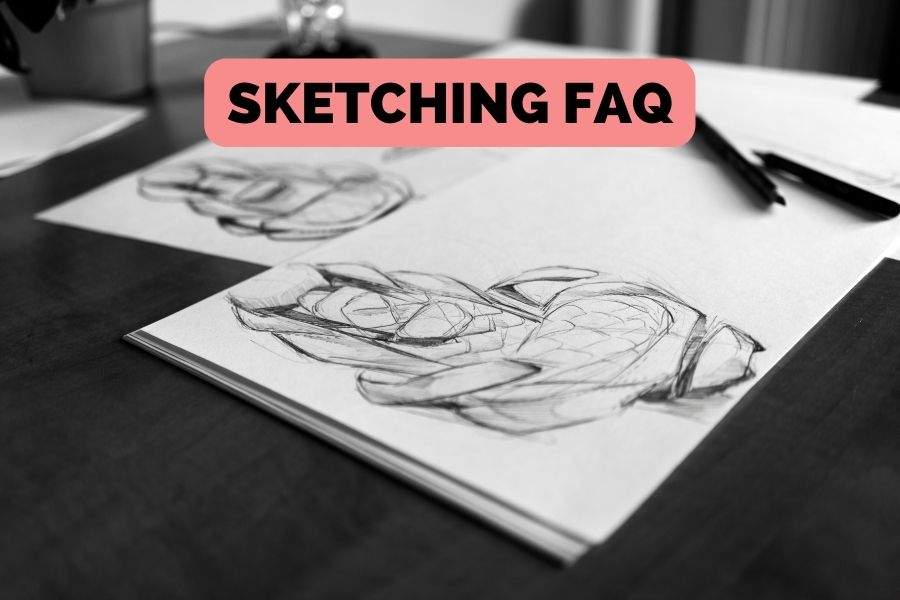
What can I use to draw on canvas?
There are a variety of materials that can be used to draw on a canvas before painting it. Some common choices include pencils and charcoal as you can easily cover it with acrylic paint. If you’re looking for a more creative option, you could also try using paints or markers to create your sketch, especially if you would like to have visible contours or silhouettes and love mixed mediums. Experiment with different materials and see what works best for you.
Can you draw on canvas before oil painting?
Yes, you can draw on canvas before oil painting. In fact, this is a great way to get started with oil painting. You can sketch your composition on the canvas before adding any paint, and this will help you to make sure that your final product is exactly what you want it to be. You can use a regular pencil, charcoal, or even acrylic paint to sketch onto the canvas before oils.
Do painters draw before painting?
Not mandatory, some paintings don’t require it at all, but some professional artists, especially those working with oil paint, either make sketches or test the paint and composition on smaller canvas or paper before painting the full-scale artwork. If we do draw a sketch before painting, we normally use a pencil and carefully mark the composition, perspective, and elements of the painting. It’s easier to make changes and corrections when you’re drawing rather than painting.
What to do before painting on a canvas?
If your canvas is not primed, please prime it with gesso to assure proper paint adhesion and color coverage. Many artists use homemade gesso or simply buy it. Once the gesso is dried and you are ready to start painting, it may be a good idea to carefully sketch what you are planning to paint, especially, if you are not sure about sizes, perspective, or composition.
Will pencil marks show through paint?
Most acrylics are opaque and cover well the surface, but some colors are more transparent by nature. Additionally, if you are imitating watercolor with acrylics and use more watery layers, creating a wash, pencil lines can be visible! In that case, make sure you make very thin and gentle lines or use a water-soluble pencil.

Masha Eretnova, born in 1991, is a Buenos Aires-based certified teacher, artist, and member of the Professional Artist Association with 20+ years of personal painting journey.
She started painting and drawing very early and is now an international abstract artist and educator passionate about acrylic painting, gouache, and crafts.
Her works are part of international exhibitions and contests, including ArtlyMix (Brazil), Al-Tiba 9 (Spain), Exhibizone (Canada), Italy, and many more.
Besides her artistic pursuits, Masha holds a post-grad diploma in Teaching Film Photography and 2 music school diplomas: piano and opera singing.

